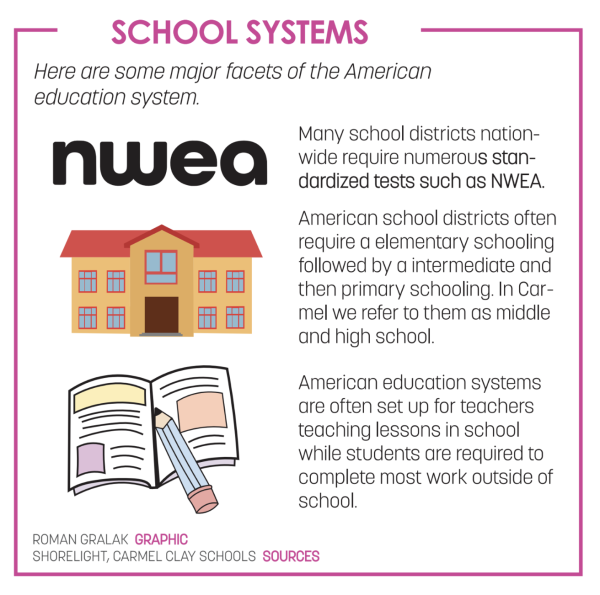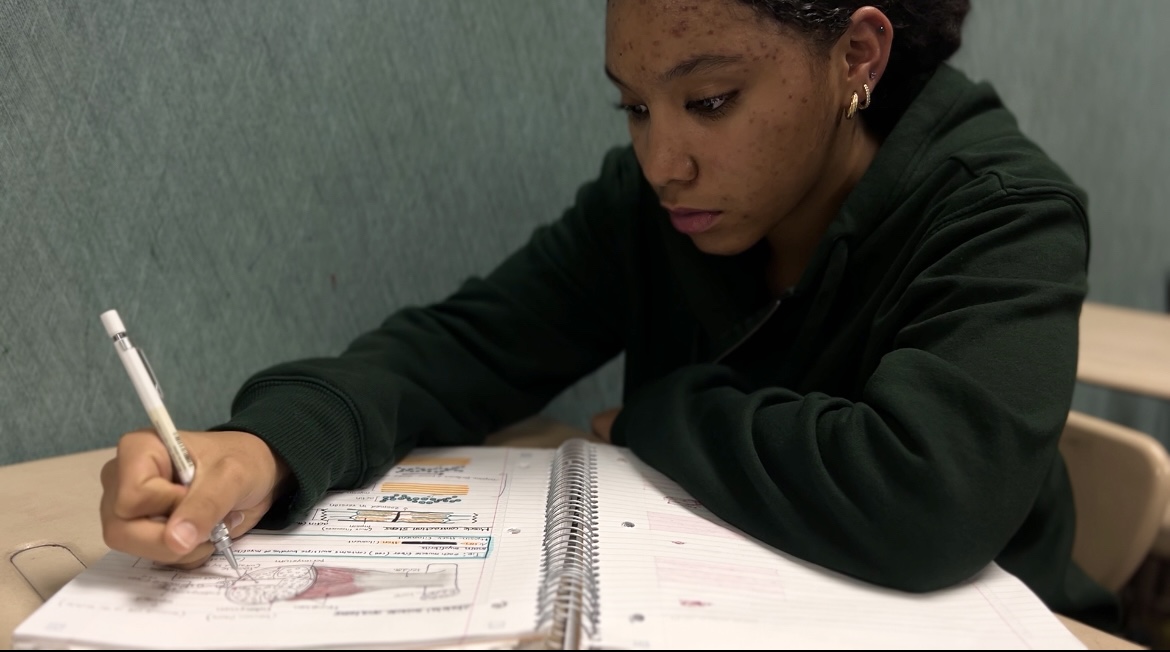Senior Claire Fackler, who attended school in Idaho up until this year, said she noticed major differences between the education she received in Idaho in comparison to CHS.
“I have an IEP (individual education program), and Carmel is a lot more organized with that. Carmel just knows what they’re doing and are way more consistent here with implementing rules, which is one of the biggest differences I’ve noticed,” Fackler said.
That type of disparity isn’t unique. Social studies department teacher John Carter said one of the biggest challenges for schools in the United States is funding, and according to a 2023 study by the Government Accountability Office, a government agency within the legislative branch, there has been declining test scores and widespread teacher shortages due to low salaries.
“Part of the biggest thing for Indiana is support from the government,” Carter said. “Being that education literally dominates everyone’s lives for the first third of their life, (and) it still seems like every year it gets harder and harder for funding or for legislation that makes our jobs easier to actually trust us as professionals.”

Fackler said that due to the noticeable funding differences for her high school in Idaho and here in Carmel, CHS provides her with more opportunities.
“There are a lot more opportunities for me, just different programs,” Fackler said. “I’m in color guard, and I love that that counts towards physical education credits, and I didn’t get that in Idaho. The funding in Idaho was significantly less, and for Carmel, we’re definitely privileged, especially with the level of color guard we perform at.”
Junior Ariyanna O’Neal has gone to school in Japan, Hawaii and California. She said her best public school experience has been Carmel.
“Teachers in Carmel really cater to the individual and there are tons of extracurriculars here,” O’Neal said. “There weren’t as many in California, but there were still some, and sports teams weren’t really great.”
O’Neal also said she is thankful, as a student thinking of going into medical school, that CHS has classes with the ability to line her up for success.
“There’s all those engineering classes and like the workshops where you would build houses and the auto shop. I know that’s not typical for most schools, but these kinda give you a head start on your career path. I like that there are tons of anatomy and biomedical classes offered as well,” O’Neal said.
Like O’Neal, Fackler said the education she is receiving here is setting her up for her chosen career path.
“(In) Carmel, I feel I am getting a better education,” Fackler said. “It’s not even more rigorous. I mean, I’m in easier classes and I’m not in any AP or anything like that, but the substance of what is taught here is much better from what I was learning back in Idaho. Everything is less filtered and I feel more confident through all the career counseling.”
Carter said the reason CHS may provide those benefits is that many teachers here have work experience beyond the classroom.
“I did several jobs before coming (to CHS) and I know several of my colleagues who worked in different fields that are now able to help advise students about what options are out there,” Carter said. “I know our college and career counseling does a pretty good job at helping students recognize paths too.”
In addition, a vital factor to a school’s education system is the socioeconomic status (SES) of the students enrolled. According to Ballard Brief, a student-led social issue research library, students of lower SES perform worse compared to those of higher SES, which contributes to a widening gap in education across the country. Fackler said there was such a gap in Idaho.
“It’s amazing that people say schools are whitewashed here (at CHS) because in Idaho, there was little to no diversity. (In) Idaho, there was a really substantial gap between people with either really high or really low household incomes, and there wasn’t really an in-between,” Fackler said.
Additionally, Carter, who taught in Kentucky, said because of socioeconomic levels, contrasting goals were set between schools.
“(At) my last school (in Kentucky), the socioeconomic levels were so different that sometimes our goal at our last school was just to up our graduation and attendance rates,” Carter said. “I know attendance here has become a little more of an issue, but that’s also partly because of COVID, but it’s a lot easier to challenge students here.”
Another important aspect of education is diversity. According to drexel.edu, more diverse school settings set up the future of students by letting them become more open-minded and confident through hearing other people’s experiences.
Fackler said because her school in Idaho was less diverse, kids who did not fit the majority demographic were often left out.
“Kids always get left out, and I feel like they went really unseen,” she said. “People in Idaho catered a lot more to the white kids with straight As who were neurotypical and that was the only student they would try to teach. If you were anything outside of that, they just didn’t know what to do with you.”
In honor of American Education Week, which takes place from Nov. 13 to 17, O’Neal said with the large number of students who go to this school, she can more easily share her unique experiences because students are more open-minded.
“Even though everyone has such different experiences, in Carmel, there are still a handful of people I can relate to in some way,” O’Neal said. “I can see similarities with all these people who have had different experiences because we’ve moved from all sorts of different places. Especially because I’m of Asian, Black and white descent, the amount of other multiracial people here is amazing.”

































![AI in films like "The Brutalist" is convenient, but shouldn’t take priority [opinion]](https://hilite.org/wp-content/uploads/2025/02/catherine-cover-1200x471.jpg)








































![Review: “The Immortal Soul Salvage Yard:” A criminally underrated poetry collection [MUSE]](https://hilite.org/wp-content/uploads/2025/03/71cju6TvqmL._AC_UF10001000_QL80_.jpg)
![Review: "Dog Man" is Unapologetically Chaotic [MUSE]](https://hilite.org/wp-content/uploads/2025/03/dogman-1200x700.jpg)
![Review: "Ne Zha 2": The WeChat family reunion I didn’t know I needed [MUSE]](https://hilite.org/wp-content/uploads/2025/03/unnamed-4.png)
![Review in Print: Maripaz Villar brings a delightfully unique style to the world of WEBTOON [MUSE]](https://hilite.org/wp-content/uploads/2023/12/maripazcover-1200x960.jpg)
![Review: “The Sword of Kaigen” is a masterpiece [MUSE]](https://hilite.org/wp-content/uploads/2023/11/Screenshot-2023-11-26-201051.png)
![Review: Gateron Oil Kings, great linear switches, okay price [MUSE]](https://hilite.org/wp-content/uploads/2023/11/Screenshot-2023-11-26-200553.png)
![Review: “A Haunting in Venice” is a significant improvement from other Agatha Christie adaptations [MUSE]](https://hilite.org/wp-content/uploads/2023/11/e7ee2938a6d422669771bce6d8088521.jpg)
![Review: A Thanksgiving story from elementary school, still just as interesting [MUSE]](https://hilite.org/wp-content/uploads/2023/11/Screenshot-2023-11-26-195514-987x1200.png)
![Review: "When I Fly Towards You", cute, uplifting youth drama [MUSE]](https://hilite.org/wp-content/uploads/2023/09/When-I-Fly-Towards-You-Chinese-drama.png)
![Postcards from Muse: Hawaii Travel Diary [MUSE]](https://hilite.org/wp-content/uploads/2023/09/My-project-1-1200x1200.jpg)
![Review: "Ladybug & Cat Noir: The Movie," departure from original show [MUSE]](https://hilite.org/wp-content/uploads/2023/09/Ladybug__Cat_Noir_-_The_Movie_poster.jpg)
![Review in Print: "Hidden Love" is the cute, uplifting drama everyone needs [MUSE]](https://hilite.org/wp-content/uploads/2023/09/hiddenlovecover-e1693597208225-1030x1200.png)
![Review in Print: "Heartstopper" is the heartwarming queer romance we all need [MUSE]](https://hilite.org/wp-content/uploads/2023/08/museheartstoppercover-1200x654.png)




